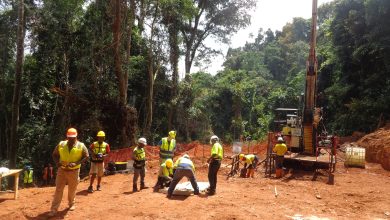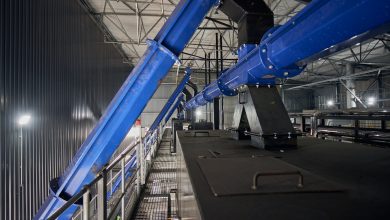
Pontoon-based pumping stations for surface & underground mining projects
Customised, Convenient and Cost-Effective Pontoon-Based Pumping
Recently, AQS Liquid Transfer designed and delivered steel-hulled pontoons to Harmony Gold’s Dam in Welkom, Free State Province. For a long-time, the company has built quite a reputation as specialists in dewatering pumps for mines and other sectors. Now, it is replicating its success in the provision of pontoon solutions for both underground and surface mining environments.
‘Cost containment’ is more than a buzzword in the current environment; it is the well-founded way for mining companies to ensure long-term sustainability for their operations. With this in mind, mining companies are continuously seeking cost-effective alternatives for ‘conventional’ technologies or methods for their operations from pit to port. Relating to the field of pumping, increasingly, pontoon-based pumping stations are regarded as an alternative to costly civils and fixed pumping stations in some fields of applications.
Perfectly placed
Recently, AQS, a reputable supplier of pumping equipment to different industries, supplied its flagship steel-hulled pontoon-based pumping stations to Harmony Gold’s Mining Project in Welkom, Free State Province, South Africa. The company is eager to deliver a similar solution to mining projects in South Africa and the region. “With our extensive experience in the provision of pumping solutions we are perfectly placed to deliver pontoons specific to open cast (surface) and underground environments,”, Howard Jones, Industrial Sales Manager, referencing the following aspects: Addressing customer specifications; Customisation of design; The scope of comprehensive turnkey solutions; and Expertise in preventative maintenance.
-
The approach
Considering that the pontoons are used in rugged conditions, the application engineers at AQS ensure that the specifications of both materials of construction and design are as precise as possible. Pertaining to construction, correct materials of construction are used, in conjunction with special marine coatings and anti-rust protection treatments that give an extended lifespan to the finished product, Jones expounds. “Depending on the operational requirements of the pontoon and the equipment on board, the materials of construction would either be Steel hulled pontoons for the larger applications or LDPE floats within a steel structure.” for more maneuverable solutions.
Moreover, all of its designs are developed using 3D modelling allowing for site and condition simulations. This ensures that any manned pontoon is stable, safe and has enough compartmental redundancy to comply with the South African Marine Safety recommendations.
-
Customisation of design
For their pontoon requirements, AQS’ customisation of design will allow for any reasonable, respective needs of clientele. The company is able to design pontoons for both electrical pumping or diesel driven systems, which allows for use in remote areas where there is no electrical grid. Furthermore, depending on the application and site conditions,the pontoons are generally anchored off-shore which assists with unwanted tampering or security issues.
If needs be, AQS is also able to provide walkways with some designs for easy maintenance and inspection. In situations where there are continuous fluctuations in the levels. Some applications require walkways which are either “fixed” to the side of the pond that swivel in the vertical plane to accommodate these fluctuations. In the longer walkway, there is a “floating” design that is anchored at three points to prevent wind and water action from moving the Pontoon around the pond.
-
Versatility
Another aspect to be considered is the versatility of the pontoons. The pontoons are deployable in both the underground and surface mining environments. “Our smallest single stack pontoon weighs less than 100kg and is able to “float” a small submersible pump of up to 150kg.
These pontoons are ideal for the underground dams, where space constraints are an issue. They are also used extensively in sumps on the surface for runoff water and storm water control,” says Jones. “In a nutshell, the pontoons can float all types of pumps or ancillary equipment for mineral sands type mining, deep mine dewatering applications and open pit operations.
-
Scope of turnkey pontoon solutions (total system)
Since the industry, specifically mines, need a ‘one-stop’ offering for their dewatering requirements, AQS has devised a wide scope of turnkey pontoon and pumping solutions. The company’s turnkey approach to project execution covers the following areas: advising, designing, costing, selling and installing and commissioning of a total system.
Suitably qualified internal staff run the project according to strict timelines and quality checks to ensure a product acceptable to global standards. The use of pre-qualified manufacturing and supply partners is required, depending on the size of the project, but the project is always run by AQS as the main supplier. “A collaborative approach is used in determining not only the clients’ needs but also the best and most economical solution,” Jones comments.
Instilling a culture of preventative maintenance
After commissioning and handing over the operation of the pontoons to clients, the team at AQS, as a standard practice, offers vital advice to the clients on ensuring high equipment availability. “We always recommend a culture of preventative maintenance to the client who insists on keeping these maintenance services in-house. However, we also have the capability to offer an SLA to mitigate the risks relative to down time. These SLA’s are generally customised to client’s needs,” Jones explains.
‘Doorstep’ supply convenience
With mining projects – both greenfield and brownfield projects – being launched, after a lull in the first half of 2020, AQS tells clients that it is well-equipped to address their pontoon needs of different magnitude. What the company’s management punt as an added advantage for potential clientele in Africa is the convenience of having a provider of pontoons locally in South Africa and easily accessible to neighbouring countries.
The proximity becomes handy when it comes to attending to problems that may crop up, explains Jones. “The reduced reaction times to attending to any onsite technical issues that may arise is paramount, as it ensures seamless operation with little or no production downtime that can be very costly for the client. In addition, one of the vital aspects handled through training sessions is the importance of the correct Installation and the Operation procedures.”






